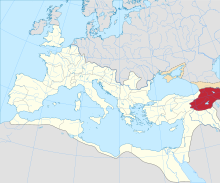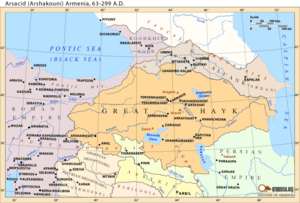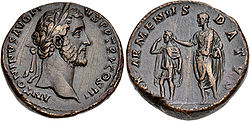Roman Armenia
| Provincia Armenia Հռոմեական Հայաստան ἐπαρχία Αρμενίας | |||||||||
|---|---|---|---|---|---|---|---|---|---|
| Provinceof theRoman Empire | |||||||||
| 114–118 | |||||||||
 | |||||||||
| Capital | Artashat | ||||||||
| Historical era | Classical antiquity | ||||||||
• Established | 114 | ||||||||
• Disestablished | 118 | ||||||||
| |||||||||
| Today part of | |||||||||
| History ofArmenia |
|---|
 |
| Timeline•Origins•Etymology |
Roman Armeniarefers to the rule of parts ofGreater Armeniaby theRoman Empirefrom the 1st century AD to the end ofLate Antiquity.WhileArmenia Minorhad become a client state until it was incorporated into the Roman Empire proper during the 1st century AD, Greater Armenia remained anindependent kingdomunder theArsacid dynasty.Throughout this period, Armenia remained a bone of contention between Rome and theParthian Empire,as well as theSasanian Empirethat succeeded the latter, and thecasus bellifor several of theRoman–Persian Wars.Only in 114 would EmperorTrajanconquer and incorporate it as a short-livedRoman province.
In the late 4th century, Armenia was divided between Rome and the Sasanians, who took control of the larger part of the Armenian Kingdom and, in the mid-5th century, abolished the Armenian monarchy. In the 6th and the 7th centuries, Armenia once again became a battleground between theEast Roman Empire(Byzantine) and theSasanian Empireuntil both powers weredefeated and replacedby the MuslimCaliphatein the mid-7th century.
History[edit]
After the fall of theArtaxiad dynastyafterPompey's campaign in Armenia in 66 BC, theKingdom of Armeniawas often contested between the Roman Empire and theParthian Empireduring theRoman–Parthian Wars.Throughout most of its history during this period, under the reign of theArsacid dynasty,theArmenian nobilitywas divided among Roman-loyalists, Parthian-loyalists, and neutrals.
Armenia often served as aclient stateorvassalat the frontier of the two large empires and their successors, theByzantineandSassanidempires. During theByzantine–Sasanian wars,Armenia was ultimatelypartitionedintoByzantine ArmeniaandSasanian Armenia.
Struggle over influence with Parthia[edit]

With the eastwards expansion of theRoman Republicduring theMithridatic Wars,the Kingdom of Armenia, under theArtaxiad dynasty,was made a Romanclient kingdombyPompeyin 66–65 BC.[1]For the next 100 years, Armenia remained under Roman influence. Towards the middle of the 1st century AD, the rising Parthian influence disputed Roman supremacy, which was re-established by thecampaignsofGnaeus Domitius Corbulo.[2]
This conflict ended after theBattle of Rhandeia,in an effective stalemate and a formal compromise: a Parthian prince of theArsacidline would henceforth sit on the Armenian throne, but his nomination had to be approved by the Roman emperor.[3]
Roman province of Armenia (114–118 AD)[edit]

In 114, EmperorTrajanincorporated Armenia into the Empire, making it a fullRoman province.[4]
From Antioch the emperor (Trajan) marched to the Euphrates and farther northward as far as the most northerly legion-camp Satala in Lesser Armenia, whence he advanced into Armenia and took the direction of Artaxata... Trajan was resolved to make this vassal-state a province, and a shift to eastern frontier of the (Roman) empire generally... Armenia yielded to its fate and became a Roman governorship... Trajan thereupon advanced and occupied Mesopotamia...and, like Armenia, Mesopotamia became a Roman province.
In 113, Trajan invaded theParthian Empirebecause he wanted to reinstate a vassal king in Armenia (a few years before fallen under Parthian control). In 114, Trajan fromAntiochiainSyriamarched on Armenia and conquered the capitalArtaxata.Trajan then deposed the Armenian kingParthamasirisand ordered the annexation of Armenia to the Roman Empire as a new province.
The new province reached the shores of theCaspian Seaand bordered to the north with theCaucasian IberiaandAlbania,two vassal states of Rome. As a Roman province Armenia was administered along withCappadociabyCatilius Severusof thegens Claudia.
TheRoman Senateissued coins on this occasion bearing the following inscription: ARMENIA ET MESOPOTAMIA IN POTESTATEM P.R. REDACTAE, thus solidifying Armenia's position as the newest Roman province. A rebellion by the Parthian pretenderSanatruceswas put down, though sporadic resistance continued andVologases III of Parthiamanaged to secure an area of south-eastern Armenia just before Trajan's death in August 117.
Roman protectorate[edit]
After Trajan's death, his successorHadriandecided not to maintain the province of Armenia. In 118, Hadrian gave Armenia up, and installedParthamaspatesas its king. Parthamaspates was soon defeated by the Parthians, and again fled to the Romans, who granted him the co-rule ofOsroenein westernGreater Armeniaas a consolation.

Sohaemuswas named king of Armenia by Roman emperorAntoninus Piusin 140. Just a few years later in 161, Armenia was lost again toVologases IV of Parthia.In 163, a Roman counter-attack underStatius Priscusdefeated the Parthians in Armenia and reinstalled Sohaemus as the Romans' favored candidate on the Armenian throne.
Armenia was in frequent dispute between the two empires and their candidates for the Armenian throne, a situation which lasted until the emergence of a new power, theSasanians.Rome's power and influence increased over the years since, but Armenia retained its independence, even if only as a vassal state, although it was a Roman ally against theSasanian Empire.When Roman emperorSeptimius Severussacked the Parthian capital ofCtesiphon,many Armenian soldiers were in his army. Later in the 4th century, they consisted of two Roman legions, theLegio I Armeniacaand theLegio II Armeniaca.[5]
In the second half of the 3rd century, the Sassanid capital ofCtesiphonand areas of southern Armenia were sacked by the Romans under EmperorCarus,and all Armenia, after half a century of Persian rule, was ceded toDiocletianin 299 as a vassal territory.[6]
Eastern Roman Armenia[edit]
In 363, a treaty was signed between theEast RomanandSassanid Persianempires, which divided Armenia between the two. The Persians retained the larger part of Armenia ( "Persarmenia" ) while the Romans received a small part of Western Armenia.
Another treaty followed between 384 and 390, thePeace of Acilisene(usually dated c. 387), which established a definite line of division, running from a point just east of Karin (soon to be renamedTheodosiopolis) to another point southwest ofNisibisin Mesopotamia. The area under East Roman control thus increased, but still, about four fifths of the old Kingdom of Armenia remained under Persian rule.[7]

UnlikeArmenia Minorwest of theEuphrates,which had been constituted into fullprovinces(Armenia IandArmenia II) under theDiocese of Pontusalready in the time ofDiocletian,the new territories retained a varying level of autonomy.Armenia Maior,the northern half, was constituted as acivitas stipendariaunder a civil governor titledcomes Armeniae,meaning that it retained internal autonomy, but was obliged to pay tribute and provide soldiers for the regularEast Roman army.[8][9]
UnderRomanrule, Melitene was the base camp ofLegio XIIFulminata.It was a major center inArmenia Minor(P'ok'r Hayk'), remaining so until the end of the 4th century. EmperorTheodosius Idivided the region into two provinces: First Armenia (Hayk',Armenia Prima), with its capital at Sebasteia (modernSivas); and Second Armenia (Armenia Secunda), with its capital at Melitene.[10]
Thesatrapiesin the south on the other hand, which had been under Roman influence already since 298, were a group of six fully autonomous principalities allied to the Empire (civitates foederatae):Ingilene,Sophene,Antzitene,Asthianene,SophaneneandBalabitene.[11]The local Armeniannakhararwere fully sovereign in their territories, and were merely required to provide soldiers upon request and to dispatch a golden crown to the emperor, as a token of submission. In return, they received their royal insignia, including red shoes, from the emperor.[11][12]
The situation remained unchanged for near a century, until a large-scale revolt by the satraps in 485 against EmperorZeno(r. 474–491). In its aftermath, the satraps were stripped of their sovereignty and their rights of hereditary succession, being in effect reduced to the status of tax-paying and imperially-administeredcivitates stipendariae.[11][12]
EmperorJustinian I(r. 527–565) carried out a series of comprehensive administrative reforms. Already soon after his accession in 527, thedux Armeniae(responsible for Armenia Minor) and thecomes Armeniaewere abolished, and the military forces of the Armenian territories were subordinated to a newmagister militumper Armeniamat Theodosiopolis.[13]
In 536, new reforms were enacted that abolished the autonomy of the trans-Euphrates territories and formed four new regular provinces.Armenia Interiorwas joined with parts ofPontus PolemoniacusandArmenia Ito form a new province,Armenia I Magna,the oldArmenia IandArmenia IIwere re-divided intoArmenia IIandArmenia III,and the old Satrapies formed the newArmenia IVprovince.[14]In 538, the Armenian nobles rose up against heavy taxation, but were defeated and forced to find refuge in Persia.[citation needed]
In 591, the treaty betweenKhosrow IIandMauriceceded most of Persarmenia to the Eastern Roman Empire.
Later history[edit]
The region was the focus of prolonged warfare in theByzantine–Sasanian War of 602–628.After the onset of theMuslim conquestsand theArab conquest of Armenia,only the western parts of Armenia remained in Byzantine hands, forming part of thethemeofArmeniakon.Armenia remained dominated by the Arabs thereafter, and was ruled by a succession of Caliphate-appointed emirs as well as local princes.
With the ebbing of the Caliphate's power and the fracturing of its outlying territories into autonomous statelets, the Byzantines were able to re-assert their influence over the Armenian principalities during the campaigns ofJohn Kourkouasin the early 10th century. In the first half of the 11th century, underBasil IIand his successors, most of Armenia came under direct Byzantine control, which lasted until theBattle of Manzikertin 1071, when all Armenia fell to theSeljuks.
Roman Christianity[edit]

The influence ofChristianitywas felt in the 1st century after Christ: Christianity was first introduced by theapostlesBartholomewandJude Thaddeus.Thus both Saints are considered thepatron saintsof theArmenian Apostolic Church.
Apostle Bartholomew is said to have been executed inAlbanopolisin Armenia. According to popular hagiography, the apostle was flayed alive and beheaded. According to other accounts he was crucified upside down (head downward) likeSt. Peter.He is said to have been martyred for having converted Polymius, the king of Armenia, to Christianity. Enraged by the monarch's conversion, and fearing a Roman backlash, king Polymius's brother, prince Astyages, ordered Bartholomew's torture and execution, which Bartholomew courageously endured. However, there are no records of any Armenian King of theArsacid dynasty of Armeniawith the name Polymius. Current scholarship indicates that Bartholomew more likely died in Kalyan in India, where there was an official named Polymius.[15][16]
Armenia became the first country to establish Christianity as itsstate religionwhen, in an event traditionally dated to 301,Gregory the IlluminatorconvincedTiridates III,the king of Armenia, toconvertto Christianity.
As a consequence ofDiocletian's victory over the Sassanids, all of Armenia was once again a vassal state of Rome by 299: Rome secured in this way a wide zone of cultural influence east ofAnatolia,which led to a wide diffusion ofSyriac Christianityfrom a center atNisibisin the first decades of the 4th century, and to the eventual full Christianization of Armenia.
Before this, the dominant religion in Armenia wasZoroastrianism(promoted by the Parthian/Sassanid Empire) and to a smaller degree localPaganism.St Gregory and his son Aristaces were successful in the full Christianization of all Armenians in the first half of the 4th century, mainly after Roman emperorConstantinelegalised Christianityin the Roman Empire in 313.

It is a well recognized historical fact that the Armenians were the first nation in the world to formally adhere to Christianity. This conversion was followed in the 4th and 5th centuries by a process of institutionalization and Armenization of Christianity in Armenia. Indeed, Gregory the Illuminator became the organizer of the Armenian Church hierarchy. From that time, the heads of the Armenian Church have been calledCatholicosand still hold the same title.
St. Gregory chose as the site of the "Catholicosate" the capital city ofVagharshapat(actual Ejmiatsin) in Armenia and built there theEtchmiadzin Cathedralas a vaulted basilica in 301-303 (Vahan Mamikonian,Roman governor of Armenia, in 480 ordered the dilapidated basilica to be replaced with a new cruciform church, still standing in the modernArmenia).
The continuous upheavals, which characterized the political scenes of Armenia in the next centuries, made the political power move to safer places often related to theEastern Roman Empire.The Church center moved as well to different locations together with the political authority, ending in ByzantineCiliciain the 13th century[17]
Episcopal sees[edit]
Ancient episcopal sees of the Roman province of Armenia III listed in theAnnuario Pontificioastitular sees:[18]
For ancient episcopal sees in the Roman provinces of Armenia I and Armenia II, seeLesser Armenia#Episcopal sees.
See also[edit]
- Legio I Armeniaca
- Legio II Armeniaca
- Sasanian Armenia
- Lesser Armenia
- Kingdom of Armenia (antiquity)
- Mamikonian
- Roman Georgia
- Byzantine Armenia
- Caucasian Albania
References[edit]
- ^Patterson 2015,p. 77.
- ^Vahan Kurkjian: Armenia and the Romans
- ^Marciak 2017,p. 360.
- ^Theodore Mommsen.The Provinces of the Roman Empire.Chapter IX, p. 68
- ^Legio II Armeniaca
- ^Zarinkoob 1999 p=199
- ^Hovannisian (2004), pp. 85, 92
- ^Hovannisian (2004), pp. 103–104
- ^Kazhdan (1991), p. 175
- ^(in Armenian)Hakobyan, Tadevos Kh.«Մալաթիա»[Malatya],Armenian Soviet Encyclopedia.Yerevan: Armenian Academy of Sciences, 1981, vol. vii, p. 145.
- ^abcKazhdan (1991), p. 1846
- ^abHovannisian (2004), p. 104
- ^Hovannisian (2004), pp. 104–105
- ^Hovannisian (2004), pp. 105–106
- ^Fenlon, John Francis. "St. Bartholomew." The Catholic Encyclopedia. Vol. 2. New York: Robert Appleton Company, 1907. 6 May 2010http://www.newadvent.org/cathen/02313c.htm
- ^Spillman, Francis. The Twelve: Lives and Legends of the Apostles. 2017.https://www.amazon.com/Twelve-Lives-Legends-Apostles/dp/1365640434
- ^Armenian Catholicosate
- ^Annuario Pontificio 2013(Libreria Editrice Vaticana 2013ISBN978-88-209-9070-1), "Sedi titolari", pp. 819-1013
Sources[edit]
- Garsoïan, Nina G. (1998)."Aρμενία μεγάλη καὶ ἐπαρχία Μεσοποταμίας".ΕΥΨΥΧΙΑ. Mélanges offerts à Hélène Ahrweiler(in French). Paris: Éditions de la Sorbonne. pp. 239–264.ISBN9782859448301.
- Hovannisian, Richard G., ed. (2004),The Armenian People From Ancient to Modern Times, Volume I - The Dynastic Periods: From Antiquity to the Fourteenth Century,Palgrave Macmillan,ISBN978-1-4039-6421-2
- Kazhdan, Alexander,ed. (1991),Oxford Dictionary of Byzantium,Oxford University Press,ISBN978-0-19-504652-6
- Marciak, Michał (2017).Sophene, Gordyene, and Adiabene: Three Regna Minora of Northern Mesopotamia Between East and West.Brill.
- Migliorati, Guido.Cassio Dione e l'impero romano da Nerva ad Antonino Pio: alla luce dei nuovi documenti.Editore Vita e Pensiero. Roma, 2003ISBN88-343-1065-9
- Mommsen, Theodore.The provinces of the Roman Empire.Barnes & Noble Books. New York, 1996ISBN0-7607-0145-8
- Patterson, Lee E. (2015). "Antony and Armenia".TAPA.145, No. 1 (Spring). The Johns Hopkins University Press: 77–105.




